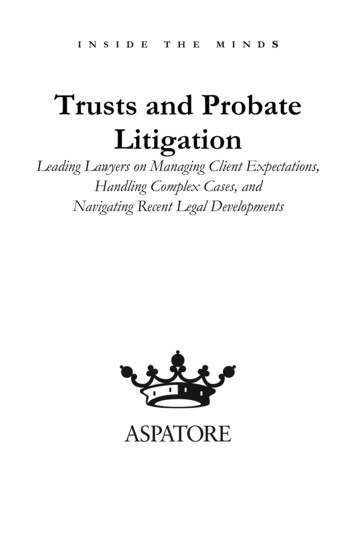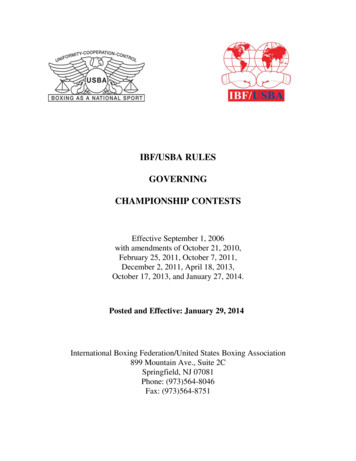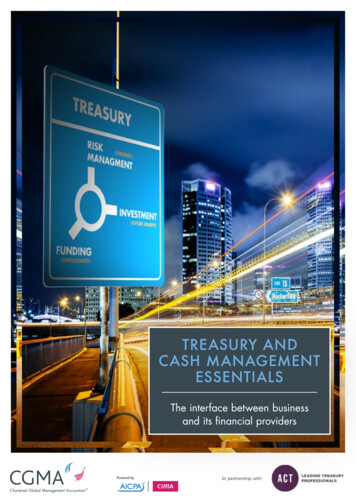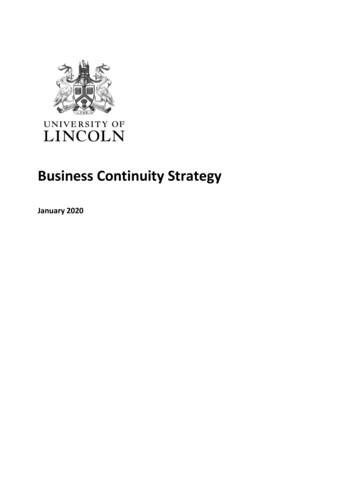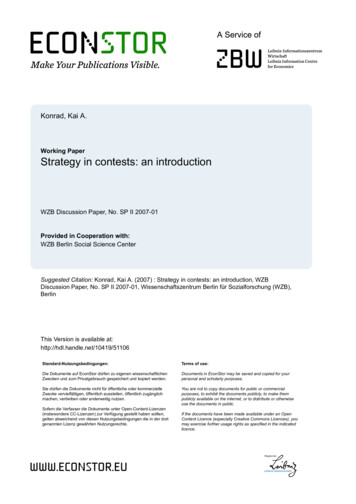
Transcription
Konrad, Kai A.Working PaperStrategy in contests: an introductionWZB Discussion Paper, No. SP II 2007-01Provided in Cooperation with:WZB Berlin Social Science CenterSuggested Citation: Konrad, Kai A. (2007) : Strategy in contests: an introduction, WZBDiscussion Paper, No. SP II 2007-01, Wissenschaftszentrum Berlin für Sozialforschung (WZB),BerlinThis Version is available ngsbedingungen:Terms of use:Die Dokumente auf EconStor dürfen zu eigenen wissenschaftlichenZwecken und zum Privatgebrauch gespeichert und kopiert werden.Documents in EconStor may be saved and copied for yourpersonal and scholarly purposes.Sie dürfen die Dokumente nicht für öffentliche oder kommerzielleZwecke vervielfältigen, öffentlich ausstellen, öffentlich zugänglichmachen, vertreiben oder anderweitig nutzen.You are not to copy documents for public or commercialpurposes, to exhibit the documents publicly, to make thempublicly available on the internet, or to distribute or otherwiseuse the documents in public.Sofern die Verfasser die Dokumente unter Open-Content-Lizenzen(insbesondere CC-Lizenzen) zur Verfügung gestellt haben sollten,gelten abweichend von diesen Nutzungsbedingungen die in der dortgenannten Lizenz gewährten Nutzungsrechte.If the documents have been made available under an OpenContent Licence (especially Creative Commons Licences), youmay exercise further usage rights as specified in the indicatedlicence.
WISSENSCHAFTSZENTRUM BERLINFÜR SOZIALFORSCHUNGSOCIAL SCIENCE RESEARCHCENTER BERLINKai A. KonradStrategy in Contests – an IntroductionSP II 2007 – 01January 2007ISSN Nr. 0722 – 6748Research AreaMarkets and PoliticsSchwerpunktMärkte und PolitikResearch UnitMarket Processes and GovernanceAbteilungMarktprozesse und Steuerung
Zitierweise/Citation:Kai A. Konrad, Strategy in Contests – an Introduction,Discussion Paper SP II 2007 – 01, WissenschaftszentrumBerlin, 2007.Wissenschaftszentrum Berlin für Sozialforschung gGmbH,Reichpietschufer 50, 10785 Berlin, Germany, Tel. (030) 2 54 91 – 0Internet: www.wz-berlin.deii
ABSTRACTStrategy in Contests – an Introductionby Kai A. Konrad *Competition in which goods or rents are allocated as a function of the variousefforts expended by players in trying to win these goods or rents is a verycommon phenomenon. A subset of examples comes from marketing, litigation,relative reward schemes or promotion tournaments in internal labor markets,beauty contests, influence activities, education filters, R&D contests, electoralcompetition in political markets, military conflict and sports. I survey here thistype of competition which is sometimes called contest or tournament. I focus onthe role of its various design aspects, such as prize structure, sequencing,nesting, repetition, elimination contests and many others. Some key insightsabout the nature and properties of this type of competition emerge from thisanalysis.Keywords: Survey of contests, tournaments, conflict, strategic aspectsJEL Classification: D72, D74ZUSAMMENFASSUNGStrategie in Turnieren – eine EinführungDie Arbeit behandelt strategische Entscheidungen in Turnier- und Wettkampfsituationen. Sie gibt einen theoretischen und empirischen Überblick und ergänztdie umfangreiche theoretische Literatur zu diesem Thema, besonders in Hinblick auf wiederholte Turniere und auf komplexere Wettbewerbsstrukturen, diesich aus verschiedenen gestaffelten Einzelturnieren zusammensetzen.* I am indebted to many colleagues who discussed this project and specific topics and made mostvaluable suggestions, in particular, Aron Kiss, Dan Kovenock, Wolfgang Leininger, Florian Morath,Johannes Münster, Shmuel Nitzan, Stergios Skaperdas and Karl Wärneryd. The usual caveat applies.iii
Contents1 An introduction to contests1.1 A de nition . . . . . . . . . . . . . . . . . . . . . . . . . . .1.2 Examples . . . . . . . . . . . . . . . . . . . . . . . . . . . .1.2.1 Promotional competition . . . . . . . . . . . . . . . .1.2.2 Litigation . . . . . . . . . . . . . . . . . . . . . . . .1.2.3 Internal labor market tournaments . . . . . . . . . .1.2.4 Beauty contests, in‡uence activities, and rent seeking1.2.5 Education lters . . . . . . . . . . . . . . . . . . . .1.2.6 R&D contests . . . . . . . . . . . . . . . . . . . . . .1.2.7 Campaigning and committee bribing . . . . . . . . .1.2.8 Military con‡ict . . . . . . . . . . . . . . . . . . . . .1.2.9 Sports . . . . . . . . . . . . . . . . . . . . . . . . . .4566991011121314152 Three types of contest2.1 The rst-price all-pay auction . . . . . . . . . . . . .2.2 Additive noise . . . . . . . . . . . . . . . . . . . . . .2.3 The Tullock contest . . . . . . . . . . . . . . . . . . .2.4 Experimental evidence and evolutionary game theory2.5 Some robust results . . . . . . . . . . . . . . . . . . .1819313546523 Timing and participation3.1 Endogenous timing . . . . . . . . . . . . . . . . . . . . . . . .3.2 Voluntary Participation . . . . . . . . . . . . . . . . . . . . . .3.3 Exclusion . . . . . . . . . . . . . . . . . . . . . . . . . . . . .53535761.4 Cost and prize structure644.1 Choice of cost . . . . . . . . . . . . . . . . . . . . . . . . . . . 644.2 Multiple prizes . . . . . . . . . . . . . . . . . . . . . . . . . . 664.3 Endogenous prizes . . . . . . . . . . . . . . . . . . . . . . . . 705 Delegation766 Externalities6.1 Joint ownership . . . . . . .6.2 Sabotage . . . . . . . . . . .6.3 Information externalities . .6.4 Public goods and free riding8282848588.2.
7 Grand contests7.1 Nested Contests . . . . . . . . . .7.1.1 Exogenous sharing rules .7.1.2 The choice of sharing rules7.1.3 Intra-group con‡ict . . . .7.2 Alliances . . . . . . . . . . . . . .7.3 Repeated battles . . . . . . . . .8 Conclusions.93939596981031041093
1An introduction to contestsThere are many types of interaction in which players expend e ort in tryingto get ahead of their rivals. Such interactions include marketing and advertising by rms, litigation, relative reward schemes in rms, beauty contestby rms and rent seeking for rents allocated by a public regulator, politicalcompetition, patent races, pleasant activities such as sports, and also ratherunpleasant events such as military combat, war and civil war are some of theexamples. These have been studied in the eld of contest theory both withinthese speci c contexts and at a higher level of abstraction. The purpose ofthis manuscript is to survey this work, focussing on the strategic aspectsof such games, their interaction with each other and within a more generaldecision framework.The theory of contests, tournaments or all-pay auctions is a dynamic eld.It was di cult when writing this survey to keep pace with the speed withwhich progress is being made. This is one of the reasons why the surveyis blatantly partial, subjective and biased. Some of the biases have beenintroduced deliberately. I have not have done justice to the large number ofempirical studies of particular contest environments and have concentratedinstead on contributions that illustrate theoretical aspects of contests thatseem to be generalizable and applicable to a wide set of contest environments.The work is also biased by the speci c aspects and topics that I becameinterested in during my own past research .There are several important lines of research which show up only marginally in this manuscript, even though whole books could be written aboutthem. For instance, from a variety of starting points researchers study investment, savings, trade and other economic activities in a world where propertyrights are not exogenously de ned but where players continuously struggleand expend e ort to appropriate and defend resources. These ‘economicsof con‡ict’ have been surveyed most recently by Gar nkel and Skaperdas(2006), and the existence of this excellent survey is perhaps a good excusefor not treating this aspect more extensively here. In addition, a whole schoolof researchers analysed the implications of rent-seeking in many speci c contexts based on Tullock (1967) and a number of other seminal papers. Severalvolumes have been published over the years that collect some of the most important contributions in this eld, including Buchanan, Tollison and Tullock(1980), and more recently Lockard and Tullock (2001). Many contributionsof this school are surveyed in this manuscript, but rather than providing abalanced survey of this literature, the focus here is on the theoretical insights into contests developed in this literature. Further, a large theoreticaland empirical literature on tournaments has been developed, particularly in4
the context of internal labor markets, and also in the context of patent racesin industrial organization. Some theory aspects of this literature are coveredin this manuscript, but the empirical studies, for instance, are not surveyedhere. These are important omissions. I hope that the many many authorswho have made signi cant contributions in these elds and whose work isnot surveyed here will be lenient in their judgement.In this chapter, I will start with a de nition of the main subject of study:a contest. Then I will illustrate the wide range of examples of this typeof structure. In chapter 2, three major types of contest are analysed morecarefully. Chapters 3, 4, 5 and 6 will consider more complex aspects of contests and questions of contest design, keeping the focus on single contests.In chapter 7, the substructure of contests is analysed, focusing on the insight that many types of contests are part of superstructures, or consist ofsubstructures, that have the nature of contests.1.1A de nitionA contest can be characterized by the following elements. First, there is aprize to be allocated among the contestants who belong to a set of contestantsN f1; ::::ng. Each contestant i 2 N can make an e ort xi , yielding avector x fx1 ; :::; xn g of e orts. These e orts determine which contestantwill receive which prize, where, in the most simple case, only one contestantgets a positive prize of some size B and all other contestants get zero. Thefunction that maps the vector of e orts into probabilities for the di erentcontestants winning the prize is(1)pi pi (x1 ; :::; xn ).Usually, in the contest literature this function is called contest success function. This suggests that, for a given vector x of e orts, the pi ’s are betweenzero and one, sum up to 1, or to something smaller than one, if there is achance that the prize is not allocated at all to one of the contestants. Toend up with the contestants’payo functions, one should note that di erentcontestants may value the prize di erently and denote vi (B) as i’s value ofwinning. Further, contestants may di er in their cost of providing a givenlevel of e ort. The relationship between e ort xi and i’s e ort cost is Ci (xi ).In most cases, and if not explicitly stated otherwise, we will assume thatCi (xi ) xi . Hence, depending on the e ort choices, contestant i receives apayo equal toi (x1 ; :::; xn ) pi (x1 ; :::; xn )vi (B)5Ci (xi ).(2)
More formally, simple contests are games that are de ned by a set N ofplayers, pure strategy spaces described by the sets of feasible pure strategiesthat are described as e orts xi 2 Xi , and by the set of payo functions as in(2).1.2ExamplesThe number of areas in which a contest is an appropriate description of howsome allocation outcomes are determined and the quantitative and qualitative signi cance of the phenomenon will be evident when a few areas ofapplication are considered. Rosen (1988) emphasized the large range of applications of contest or tournament theory and mentioned applications suchas examinations, college admission, quality control and medical trials, athletic competitions, elections, litigation, auctions, R&D races, work-pointsincentive schemes, and relative payment schemes in organizations. One maywant to add advertising and other types of promotional competition, rentseeking and appropriation con‡ict in which players use resources in trying tode ne or reallocate property rights between them, and also one of the mostviolent types of con‡ict: civil war or war between countries. We discuss aselection of these examples here and illustrate some of the research questionsthat emerge in this context.1.2.1Promotional competitionFirms try to increase their market shares by advertising campaigns and othermarketing activities. Most obvious cases are newspaper advertisements or tvspots for, for example, washing powder or soft drinks, and sales agents whotry and persuade customers to buy a particular product. Such activities havein common that the major share of these e orts are made up-front, prior toactual sales, and can be understood as e orts in a contest in which the e ortchoices determine the market shares of all rms. The contest success functiondoes not have a probabilistic interpretation in this case, but can be seen asthe share in the total market.The expenditures on marketing and advertizing are substantial, and sometimes they are subject to regulation. In the German insurance markets, forinstance, the maximum amount of promotional activities by insurance companies was regulated and constrained from above to 30 percent of premiums,and commissions paid to sales agents were limited to no more than 11 percentof premiums (Rees and Kessner, 1999). Figures for pharmaceutical companies are similar. Figures 1 and 2 depict both the advertizing-to-sales ratio6
3,2503,0002,7502,5002,250EDUCATIONAL SERVICESRETAIL STORES, NEC2,000GAMES,TOYS,CHLD VEH,EX DOLLS1,750PERFUME,COSMETIC,TOILET PREPSOAP,DETERGENT,TOILET PREPS1,500CIGARETTESBTLD & CAN SOFT DRINKS,WATER1,250MALT BEVERAGES1,000BEVERAGESFOOD AND KINDRED 022003Figure 1: Advertising expenditure as a percentage of sales revenues in a number of advertising intensive sectors in the US. Data Source: www.AdAge.com,Advertising to Sales Ratios, various years.and the marketing-to-sales ratios for the industries with the highest ratios in2003 for the US.The share of promotional e ort in sales revenue is even higher if this ismeasured not only by advertising campaign costs but also by marketing e ortmore generally, as is shown in Figure 2.These gures document the fact that advertising and other types of promotional or marketing activities are very commonly used tools in competitionbetween rms. The contest nature of this type of competition was noticedquite early by Friedman (1958), Mills (1961) and Schmalensee (1976).Firms that spend resources on advertising will generally a ect their market share, but advertising may also change the total size of the market.1Advertising expenditures therefore have the properties of a contribution to apublic good. But they also have a negative externality if such expendituresa ect market shares. This speci c e ect makes promotional competition acontest in which the prize at stake is a function of the contestants’e orts.1The two roles of marketing e ort with aggregate e ort a ecting market size and relative e ort a ecting market share has also been pointed out by Bell, Keeney and Little(1975, p.136). The empirical assessment of how advertising in‡uences market size andmarket shares for a particular type of consumer good is still a matter of ongoing research.7
006,005,004,003,002,001,000,00RETAIL STORES, NECGAMES,TOYS,CHLD VEH,EX DOLLSPERFUME,COSMETIC,TOILET PREPSOAP,DETERGENT,TOILET PREPSCIGARETTESBTLD & CAN SOFT DRINKS,WATERMALT BEVERAGESBEVERAGESFOOD AND KINDRED PRODUCTS1997199819992000200120022003Figure 2: Marketing expenditure as a percentage of sales revenues in a number of advertising intensive sectors in the US. Data Source: www.AdAge.com,for various years.This aspect will be considered from a theory point of view in section 4.3.2 Ofcourse, the advertising game is more complex than simple contest game insection 1.1 because repetition, the dynamics of advertising and the e ects onthe stock of consumers, possible collusive behavior between the competitors,and the size of rms within the group of largest rms may also a ect theresults. Advertising expenditures, and marketing activities more generally,also have the property that they may be used to hurt particular competitors,and thereby reduce one particular competitor’s market share. This activitycould be called sabotage and is di erent from e ort that enhances a rm’sown market size, as it will bene t not only this rm but also other rms thatare not a ected by the sabotage e ort. The role of sabotage more generallywill be considered in section 6.2.2See, e.g., Piga (1998) and Gasmi, La ont and Vuong (1992). The latter report that thesoft drink producer Coca-Cola’s advertizing expenditure prior to 1977 had adverse e ectsfor the demand for Pepsi, whereas Pepsico Inc.’s advertizing expenditure had a weakstimulating e ect on the demand for its rival, the Coca-Cola Company. The di erentiale ects on market share and market size are, however, not the only possible explanationsfor this, as price competition, for instance, may also have played a role.8
1.2.2LitigationAnother practical example where contest e ort in‡uences the probabilitieswith which agents win or lose is litigation (Farmer and Pecorino, 1999, Wärneryd, 2000, Baye, Kovenock and de Vries, 2005 and Robson and Skaperdas,2005). The international comparative evidence on the cost of litigation isnot very extensive.3 Business law, institutions, and, in particular, the institutional design of the litigation process play major roles for the quality ofproperty rights in a country, and for the amount of resources used in litigation. Shavell (1982) has drawn attention to the importance of fee shiftingrules for plainti s and defendants, and Spier (2005) surveys the theoreticalliterature. Baye, Kovenock and deVries (2005) discuss the importance offee shifting rules for litigation e ort in a contest model of litigation. Theydiscuss the ‘American rule’, by which each litigant covers his own cost, the‘English rule’, by which the loser pays the cost of both parties, and othercost shifting arrangements.Litigation is a complex matter. Plainti s have to decide whether to makedemands, and what kind these will be, defendants have to decide how toreact, how to negotiate in a pre-litigation period, whether to employ laywersat that stage, and whether to enter into litigation in court, and this, again,becomes a multi-stage game with multiple options. The design of the legalsystem determines the rules of this game. The game has elements of contestsat many stages. The theoretical analysis in the main part of the book willimplicitly address many of these strategic aspects, such as the role of feeshifting rules, the entry decision, delegation, information, and informationasymmetries in contests.1.2.3Internal labor market tournamentsTournaments, or relative performance reward schemes, are well establishedin many working environments. Promotion decisions in organizations arealso often based on relative performance, and sometimes rms explicitly, andrepeatedly, award prizes to employees, typically rewarding individuals or asubset of their best performing employees. These schemes have the structureof a contest as the employees expend e ort in trying to win a prize.Lazear and Rosen (1981) and Rosen (1986) started the formal study ofsuch structures in the labor market context, and the empirical importance3The European Union Labour Force Survey 2003 gives the number of legal professionalsfor European countries. Normalizing these numbers by the number of citizens gives thenumber of legal professionals per 1000 citizens, and this ranges from 0.93 for France up to3.41 for the Netherlands.9
and the theoretical properties of internal labor market tournaments havebeen studied carefully in a large literature that had its origin in these twopapers.4 Many issues that have been analysed, and are highly relevant inthese contexts, are surveyed in later sections here. Tournaments in both thelabor market and organizations are typically carefully designed. The designermay consider awarding one or many prizes, may award by means of a simpleor more complex structure of the tournament with multiple rounds, with orwithout entry barriers, and with or without elimination of some contestantsat early stages of the tournament. The designer also may have various objectives in mind. In some rms, the tournament may simply serve as a rewardscheme meant to induce workers to expend e ort that translates into output. In other rms, the tournament may also serve as a screening devicethrough which the rm wants to identify employees who are particularlygood at pursuing superior tasks or at assuming more responsibility, and thismotivation may even dominate in some rms and some internal labor market tournaments. Firms may also consider that relative rewards may induceemployees to exert destructive e ort, e ort that does not improve their ownperformance, but reduces the performance of their competitors, and theymay consider how to organize the tournament so as to reduce such sabotageincentives. These are some of the strategic aspects that play a role in labormarket tournaments which will be considered further below.1.2.4Beauty contests, in‡uence activities, and rent seekingEconomic rents are often allocated by bureaucrats or politically appointeddecision makers. Accordingly, those who are the possible bene ciaries of theirdecisions may try to in‡uence these decisions. Firms or consumer groups mayattempt to receive favorable treatment from a regulator, rms may lobby fortari s or other forms of import protection, and these are early examples ofrent seeking that were discussed, e.g., in the classical contributions on rentseeking by Tullock (1967), Krüger (1974) and Posner (1975).The literature on the various applied aspects of rent seeking contests isvast, and protectionist trade policy, industry regulation, privatization, development policy, and foreign aid are some of the topics that have receivedmuch attention. An early survey is that of Nitzan (1994). There is a morerecent survey of the theory of rent seeking and its applications by Congleton, Hillman and Konrad (2006). Many of the aspects that are dealt within this literature will be discussed later on, e.g., issues of who is willing toparticipate, and who is admitted to the contest, who de nes the rents, who4See, e.g., Lazear (1995) for a brief survey of the early literature.10
bene ts from the rent seeking expenditure, and who sets the rules of the rentseeking game.5Obvious examples of beauty contests that regularly receive public attention are the games that determine the choice of locations for the Olympicgames by the International Olypmic Committee (IOC), or for soccer championships by the Fédération Internationale de Football Association (FIFA).The locations that want to host these events expend considerable resourcesin trying to in‡uence the decisions favorably. Steward and Wu (1997) surveysome of the literature on decision making by the IOC. They report o ciallystated campaign costs by the cities that applied for the 2000 Olympic games:25.2 million Australian dollars by Sydney, and 86 million D-Mark by Berlin.They also suggest that these o cial numbers underestimate the actual payments.Beauty contests are also common in other contexts. For instance, the allocation of broad band telecommunication rights often occurred in beauty contests in countries in which they were or are not simply auctioned. Goree andHolt (1999) discuss the case where the U.S. Federal Communications Commission awarded 643 licenses among 320,000 applications, before switchingto auctioning licenses. Hazlett and Michaels (1993) estimate that the application costs added up to about 40 percent of the value of the licenses, forwhich they give an estimate of 1 billion USD. The allocation of spectrumrights by way of a beauty contest has not been unusual in recent years. According to Börgers and Dustman (2003), who describe the di erent processesthroughout Europe for awarding broad band (3G) spectrum licenses, beautycontests have been used in Finland, Spain, Sweden, Portugal, France, Ireland,and Luxemburg. Considering the rent seeking cost of these cases, in‡uenceactivities could emerge both at the stage where the design of the allocationmethod had to be chosen, and in the actual contest between rival competitorsfor the spectrum rights for a given design and a given set of licenses.1.2.5Education ltersEducation is a less obvious example of contest games. Education may serveas an input that enhances individual human capital and translates into higherlabor productivity. However, education may also function as a lter whichreveals the true characteristics and abilities of a person, thus allowing animproved and more productive use of the person’s abilities in the assignmentof tasks. The latter purpose of education was highlighted by Arrow (1973),5For this aspect, see for instance, Appelbaum and Katz (1986), Hillman and Katz(1987), Ellingsen (1991), Drook-Gal, Epstein and Nitzan ( 2004) and Epstein and Nitzan(2004, 2006a, 2006b).11
and this aspect is popular among sociologists. Hirsch (1977), for instance,considers the role of the education system in lling a number of attractivepositions in a society, and acknowledges the tournament aspect of such systems. The scarcity of attractive tasks in the assignment process on the onehand, and the relative comparisons in the ltering process on the other makethe assignment problem similar to a rent seeking contest. To the extent thatthe allocation of jobs and tasks is decided on the basis of relative ability andnot absolute ability or actual productivity or skills developed, some of thee ort that is expended in education could be wasteful.6 Many of the strategicaspects discussed in later sections therefore apply to this context.Empirically, the e ort expended on education is substantial. In 2002,the average overall expenditure in the OECD was USD 5273 per student atthe primary level, USD 6992 per student at the secondary level, and USD13343 per student at the tertiary level (OECD, Eduation at a Glance, 2005,p. 161). These numbers underestimate total e ort, as they mainly measurethe actual resources spent on teachers and teaching institutions, and do notinclude the opportunity cost of time.1.2.6R&D contestsOne of the areas of application in which the tournament character of players’interaction is also very visible, and in which the theory of contests andtournaments made major progress early on, is the area of research and development (Loury 1979, Nalebu and Stiglitz, 1983). The rm which introducesa new product or a product improvement rst will generally have some bene t from it. The rm may earn some monopoly rent as long as there are nocompetitors who can o er a similar product or quality, and patent protection may further increase this rent. Accordingly, rms may spend e ort onresearch and development when chasing these rents.Many R&D contests emerge naturally from rms’ competition, the potential pro tability of introducing new products, or the advantage of costreducing innovations. However, a large number of technology prizes whichseveral rms may contest for, are also awarded. Windham (1999) has collected a considerable list of examples. He mentions the famous contest for6The tournament structure of education systems has also been recognized by contesttheorists. Amegashie and Wu (2004) consider national exams as a contest that is devised toassign students to the di erent institutions of higher education. They nd that students’selection choices about where to apply for higher education prior to preparing for theexams that produce the basis for the admission procedure can be dysfunctional. Konrad(2004d) considers the role of mobility and transition options between di erent, multistage education lters for e ciency. Fu (2006) considers handicapping of applicants fromminorities in college admission competition.12
a “practical and useful” means of determining longitude at sea’(Windham1999, p. A-3) for which the British Parliament o ered a prize of GBP 20000 in 1714, the ‘Wolfskehl Prize for proving Fermat’s Last Theorem’, theEU Information Technology prizes, and a long, and non-exhaustive, list oftoday’s recognition prizes.1.2.7Campaigning and committee bribingPolitical competition is another area in which contest theory has major applications. Parties spend resources in trying to in‡uence voters and winelections, whereas party members and politicians expend e ort to advancewithin the party hierarchy or to be nominated for an important o ce. Suchelectoral competition and party politics resemble the promotional activitiesof rms who use advertising with the aim of both increasing the market - inelectoral markets the aim is an increase in votes turnout, and increasing theirown share in this market. The empirical signi cance of the phenomenon islarge. One measure is, for instance, the considerable size of campaign budgetsof parties or candidates who run for government or o ce in democratic election campaigns. Some illustrative gures are reported by Alexander (1996).According to this source, Abraham Lincoln’s campaign cost were about 100000 USD, John F. Kennedy and Nixon spent about 9.7 million USD and 10.1million USD respectively. Bill Clinton could draw on more than USD 130million. But also in parliamentary systems the cost of campaign spending issigni cant. In a much smaller country such as Germany, the two largest parties’expenditure were estimated to sum up to about 50 million Euro (
Kai A. Konrad, Strategy in Contests - an Introduction, Discussion Paper SP II 2007 - 01, Wissenschaftszentrum Berlin, 2007. Wissenschaftszentrum Berlin für Sozialforschung gGmbH, Reichpietschufer 50, 10785 Berlin, Germany, Tel. (030) 2 54 91 - 0 Internet: www.wz-berlin.de .



